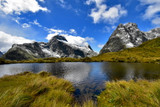Night Photography - The Milkyway
I love getting out at night and getting photos of the night sky. Because of the annual and nightly rotation of the night sky, getting a shot in a chosen setting with the stars in the aspect that you want them can often come down to only a few nights in a row where every thing lines up with the moon below the horizon and hopefully a clear night. Waste light from our modern cities is also a real problem when it comes to getting a clear shot of the night sky.
There are a number of technical difficulties with getting a shot of the whole milky way. The first is that it covers a large expanse of sky so even with my 10mm lense it just doesn't fit into a single frame which means I meed to take a number of shots and merge them together to make a panorama.
The difficulty with night time panaromas is that the night sky doesn't stay still but keeps on quietly rotating as you take your different frames and since you need to take long exposures for each frame, there is enough movement in the stars to prevent the frames matching up properly.
I use a 10mm lense for these night time panoramas. I set my camera for iso 8000 and open the lense right up on manual to its widest f stop (f3.5). With this setting I typically use an exposure of approx 14sec. With a 10mm lense you can get away with exposures up to about 24sec before the stars all start appearing as lines rather than dots as the exposure time starts to pick up the stars rotation. The exposure time needs to be reduced if you are using a longer focal length. If I'm taking a single shot I'll use an exposure time of around 24sec to bring out the back ground setting more. I always use manual focus at night. I check all my lenses during daylight to record where the focus at infinity point is at different focal lenghts so that I can accuratley set the focal point. Don't assume that your lense is automatically at infinity when you've rotated the focal ring to the maximum setting. For most modern lenses, the infinity focal point is typically not at the max setting and not always constant across the range of a zoom lense.
As stated, for panoramas I usually work with about 14 sec per frame and then work quickly spinning the camera on the tripod to get the overlapping frames required to make up the panorama. The longer the exposure, the more rotation occurs over tthe duration of taking the set of frames and the harder it is to match up the frames to create the panorama. Photoshop photomerge tends to distort the top of the frames when merging to compensate for the stars rotation . The 14 seconds seems to be a practical balance between capturing the light of the night sky and still being able to merge the photos. Also you should always work from east to west when taking these night time panoramas so that you are moving in the direction of rotation. (It took me a while to figure out that night time panormas where I worked from west to east just didn't work out as well when I tried to merge them.)
I've made several attempts to get good shots of the milky way curving out over the Tasman sea from the top of Paritutu but the combination of waste light from the city and light sea mist often makes this impossible. I tried again a few nights ago but conditions just weren't any good for clear night photography. After unsuccesfully trying a couple of different locations I gave up and came home at about 4am and as i drove up our drive I suddenly realised that the milky way curving over our house would make a great shot.
The shot below is a photomerge of 6 frames with 14 second exposure. The original photomerge was quite distorted and it took some careful manipulation to straighten it back out to give the final result.

This second shot is a vertical panorama where I've panned vertically up and over. This shot is comprised of five 14 second images.

Recent Posts
-
The Milford Track
For the last few years my daughter Sarah, her fiance Sach and myself have been completing a great w …13th Feb 2024 -
The Waikaremoana Great Walk
We had originally planned to walk the Waikaremoana track in Februrary 2022 but with uncertainty over …31st Jan 2023 -
The Routeburn Track
We were going to walk the Waikaremoana Track this February but had concerns that the track might not …27th Feb 2022




